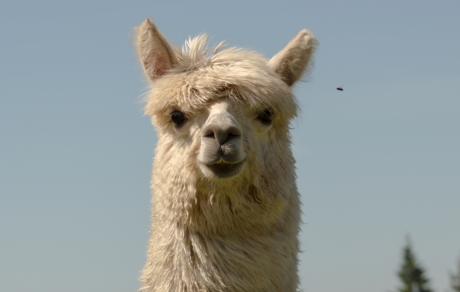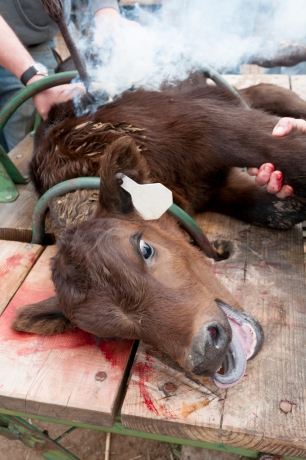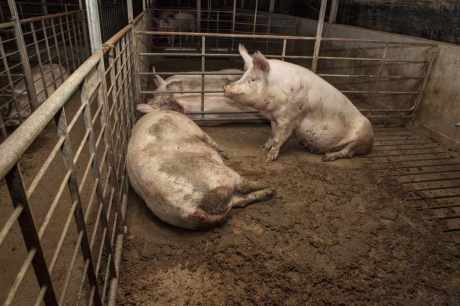The Victorian Farmers Federation (VFF) describes itself as “an active, powerful lobby group dedicated to the interests of farmers and making a difference to communities”.
On 5th January 2018, the organisation issued a statement in which it said it had “slammed” key aspects of the Victorian state government’s recently released animal welfare action plan.
In what he described as a “stern warning to government”, president David Jochinke condemned the proposal to introduce the concept of sentience to animal welfare legislation.
In its action plan, the government had described “sentience” as the notion that animals “experience feelings and emotions such as pleasure, comfort, discomfort, fear and pain”. Similarly, the Oxford dictionary defines the adjective “sentient” as “able to perceive or feel things“.
The government’s examples of pleasure and fear are psychological in nature, while comfort, discomfort and pain can be psychological and physical.
In condemning the government’s proposal, was Jochinke implying that animals do not experience physical and psychological pain?
Alternatively, was he implying that any pain they may experience does not matter?
Jochinke claimed the proposal would “introduce language into law that can be manipulated by animal extremists for their own purposes”.
It is easy to brand people as “extremists” when they act on the belief that animals have a right to live without being exploited by farmers and others.
Are those farmers not extreme when they harm animals? At the present time (as referred to in more detail below), they are permitted to perform acts that would be illegal if they involved a companion animal such as a dog or cat.
The “purposes” of so-called “animal extremists” generally involve protecting the interests of animals, unlike the profit motive, at animals’ expense, of most farmers.
Cartesian scientists and farmers
The term “Cartesian scientists” stems from the seventeenth century philosopher René Descartes, who argued that only humans have minds and therefore the ability to think. His followers took the argument to also mean that animals cannot feel.
In his book “Animals like us”, author Mark Rowlands wrote:
“If you were an animal in the seventeenth or eighteenth centuries, then one of the things you should have made a point of avoiding would be Cartesian scientists. If not, then, you could expect to find yourself nailed to a vivisection board, being slowly cut open. You would be conscious throughout. The Cartesian scientists did not take any steps to prevent your suffering or pain for one very simple reason: they did not believe you were capable of suffering or feeling pain.”
Like most of us, VFF and its members may be horrified by the actions of Cartesians, as described by Rowlands. However, routine actions of farmers at the current time, with the full support of the law, are also deplorable. Such actions are currently permitted by means of exemptions to the erroneously titled “Prevention of Cruelty to Animals Act”.
As I have stated elsewhere, the government continues to outrageously claim the exemptions do not permit cruelty to occur when, by their nature, they do.
Here are a few examples (generally performed without pain prevention or relief): hot-iron branding; tail docking; ear notching; teeth clipping; castration; dehorning; removal of toe segments; lifelong confinement indoors (often in cages); forced separation of mothers and babies; and forced breeding, often involving stimulation by humans, penetration with artificial devices, and ongoing confinement.
A key concern for farmers
In an article written for Stock and Land, VFF livestock president, Leonard Vallance, stated:
“The introduction of sentience into law will only provide a platform for the argument against the existence of farm animal production systems as has been exposed by extremists in Europe.”
If Vallance is seeking to indicate that horrific routine practices only occur overseas, then his claim is not valid. Such practices have been extensively exposed in Australia, with a prominent example being the Aussie Farms website.
Vallance’s concerns about a platform for arguments against farm animal production systems may be well founded. Legislation that acknowledged sentience and was claimed by its authors to promote care and respect of animals, while also allowing acts of cruelty, could be regarded as callous and contradictory.
There is no indication in the government’s action plan that it intends removing legislative exemptions. Indeed, the plan appears to strongly support the livestock sector.
Even where standards or codes of practice stipulate protective practices, they are often vague and therefore easy to overlook. For example, the Australian Animal Welfare Standards and Guidelines for Sheep specify that “sheep and lambs should be provided with adequate shelter”. They go on to say that, in the absence of natural protection, “consideration should be given” to the provision of shade, windbreaks or sheds.
Farmers may briefly consider such measures, without necessarily doing anything about them. It was estimated in 2012 that around 15 million lambs die each year in Australia within 48 hours of birth due to inadequate protection in bitterly cold conditions.
VFF vice president creates a new word
The VFF’s vice president, Brett Hosking, recently released a video on Twitter, expressing concern over the government’s action plan. In it, he appears to have created a new word, “sentenance”. He used it or “sentinent” four times, presumably intending to mean “sentience” and “sentient”.
Hosking only referred to the psychological aspects, failing to acknowledge the physical component. (He used words such as “emotions”, “thoughts”, “happy”, “sad”, “nervous”, “anxious”, “scared”, “afraid” and “excited”.)
As indicated by these comments, he is not convinced that any animals are “sentinent”:
“Whether animals are ‘sentinent’ or not, I’m not really sure. I like to think that when my dog runs up to see me in the morning that he’s running up because he wants to hang out with me because I’m a fun fellow, but it could be just instinct because he’s used to, you know, [he] knows that things are all right when I’m around.”
He also reiterated a point made by VFF in its statement, by arguing that using the word “sentinent” in legislation would mean, “what we’re kind of saying is that animal welfare depends on the animal, not on the person doing it.”
The VFF’s statement argued: “Animal welfare law is about addressing human behaviour towards animals, not addressing animals”.
Leonard Vallance made a similar point in his article.
In his video, Hosking went on to say:
“It’s kind of like saying that if the animal doesn’t get sad or upset, then it’s all right to be cruel to them, and that doesn’t really rest easy with me. [It’s a] little bit like saying it’s okay to discriminate against someone as long as they don’t realise it’s happened.”
That is a fallacious argument, in that it fails to acknowledge the fact that all animals farmed by VFF members are sentient. Hosking and VFF seemingly fail to accept that the existence of animal sentience, and the need to prevent cruel practices, are inextricably linked.
Here’s the tweet:
Conclusion
With the Victorian government failing to indicate it will remove legislative exemptions in favour of the livestock sector, along with the VFF’s attitude toward sentience, what chance do “production” animals have of avoiding cruelty?
The most effective way to minimise cruelty in food consumption is to avoid animal-based products. We have a choice, and should use it for the benefit of those who have none.
Author
References
Victorian Farmers Federation, “About us”, https://www.vff.org.au/vff/The_VFF/AboutUs/vff/About_Us/About_Us.aspx?hkey=d1685f71-c8b5-43ae-b571-a2594d327d9d (accessed 22 Jan 2018)
Victorian Farmers Federation, “Farmers condemn unnecessary animal welfare legislation”, 5 January 2018, https://www.vff.org.au/vff/Media_Centre/Media2018/Farmers_condemn_unnecessary_animal_welfare_regulation.aspx
Agriculture Victoria, Animal Welfare Action Plan, Jan 2018, http://agriculture.vic.gov.au/agriculture/animal-health-and-welfare/animal-welfare/animal-welfare-action-plan
Rowlands, M., “Animals like us”, Verso Books, London, 2002 (p. 3)
Agriculture Victoria, “Prevention of Cruelty to Animals Legislation”, http://agriculture.vic.gov.au/agriculture/animal-health-and-welfare/animal-welfare/animal-welfare-legislation/prevention-of-cruelty-to-animals-legislation (accessed 23 Jan 2018)
Victorian Farmers Federation, “Livestock Group”, https://www.vff.org.au/vff/Industries/Livestock/Industry_Structure/vff/Industry_Groups/Livestock/Industry_Structure.aspx?hkey=ffb4d11e-ed46-4217-8a21-426c01a08e2a (accessed 22 Jan 2018)
Vallance, L., “Farmers care about the welfare of animals”, Stock and Land, 11 Jan 2018, http://www.stockandland.com.au/story/5160138/farmers-care-about-the-welfare-of-animals/?cs=4587
The Aussie Farms Repository, http://www.aussiefarms.com.au/ (accessed 23 Jan 2018)
Australian Animal Welfare Standards and Guidelines: Sheep, http://www.animalwelfarestandards.net.au/sheep/
Neales, S., “End to the silence about 15 million dead lambs”, The Australian, 3 Sep 2012, http://www.theaustralian.com.au/news/nation/end-to-the-silence-about-15-million-dead-lambs/news-story/dcfd08eddf63e33380a5f26004c596bf (This reference relates to the main image, as referred to below.)
Victorian Farmers Federation, “Board of Directors”, https://www.vff.org.au/vff/The_VFF/Board_of_Directors/vff/About_Us/Profiles.aspx?hkey=ade72ab8-85f4-4c59-8572-e8cc5827c671 (accessed 22 Jan 2018)
Hosking, B., Twitter @HoskingBrett, 17 Jan 2018, https://twitter.com/HoskingBrett/status/953428962943819776










